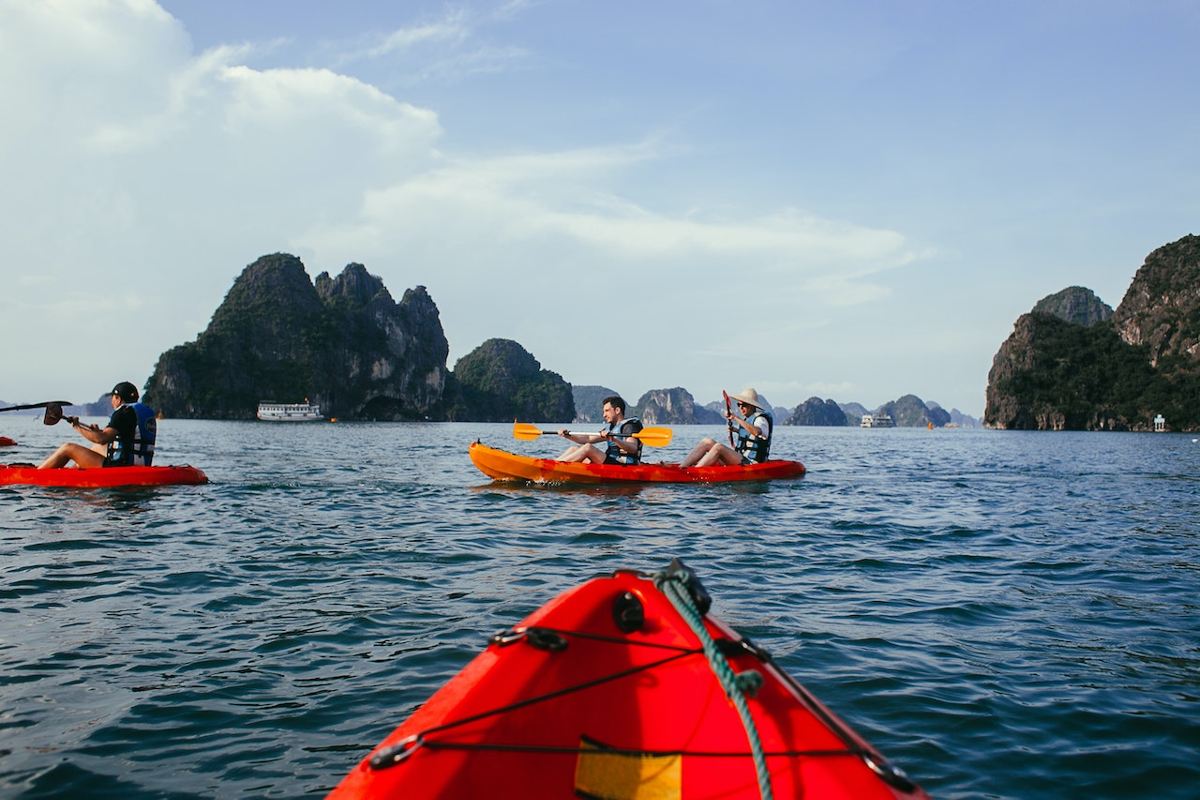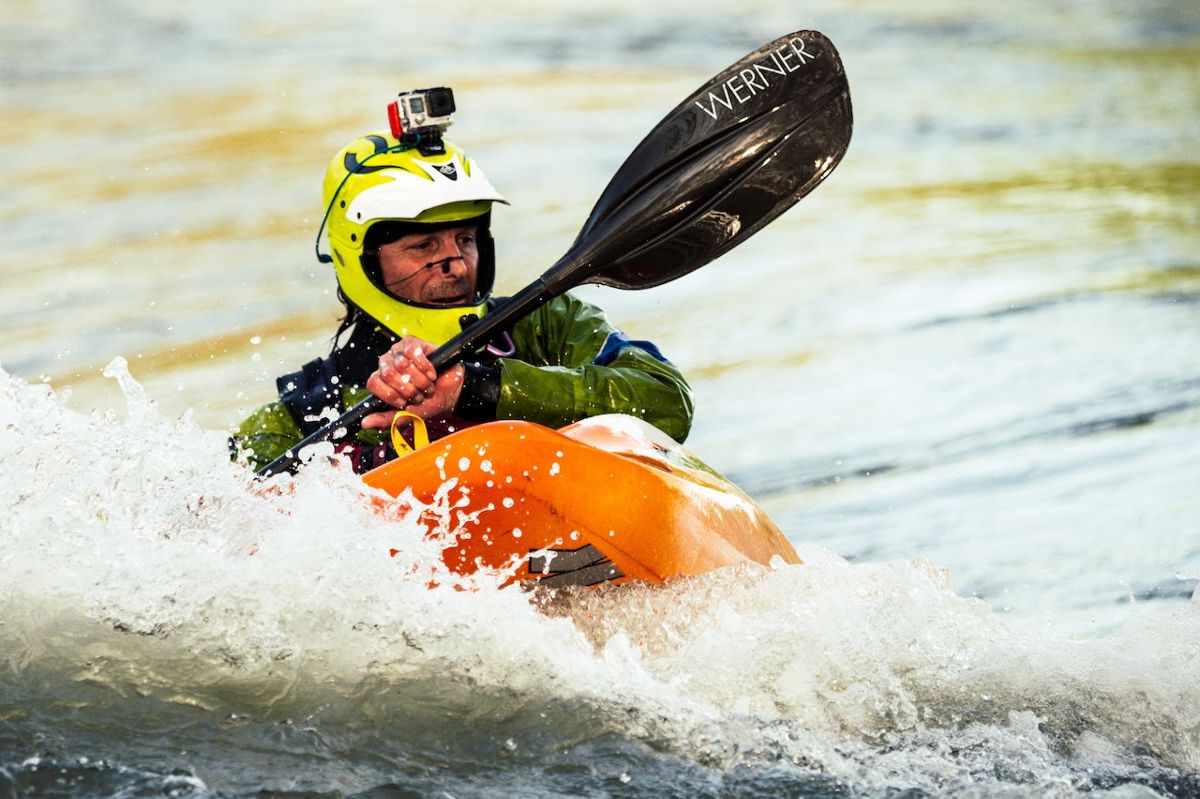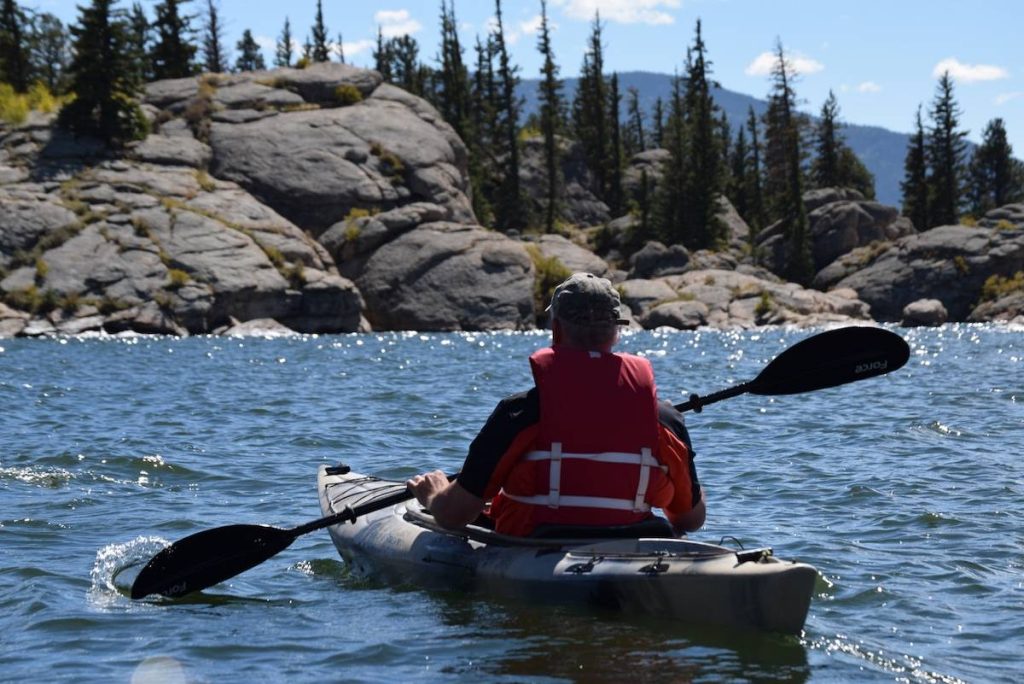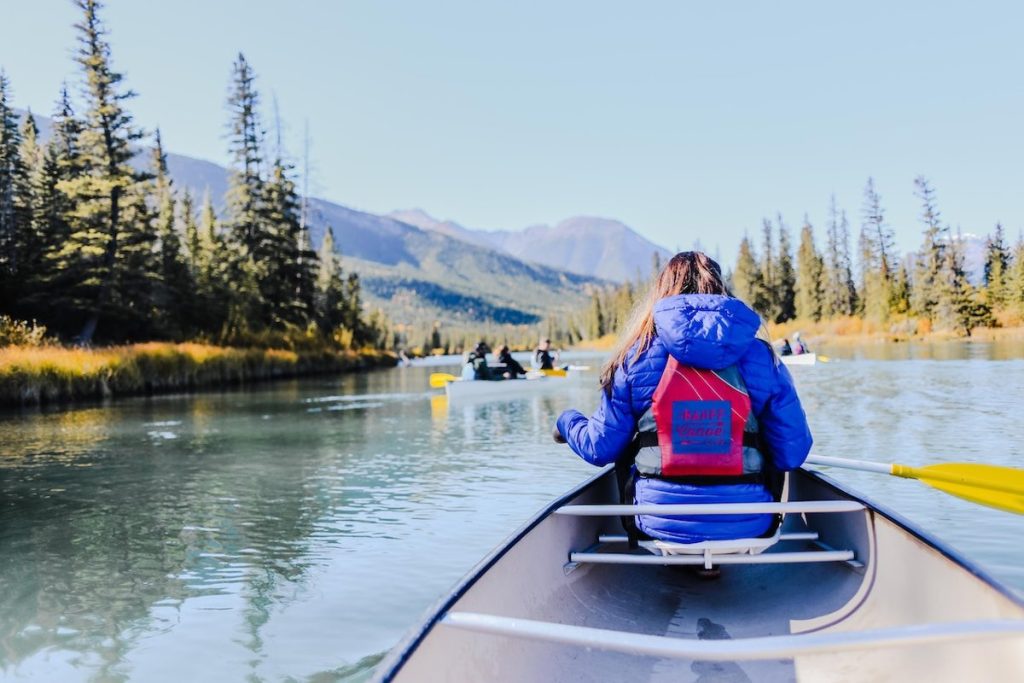Let’s dive into the wonderful world of kayaking and explore what clothing should be worn for this exhilarating activity!
When it comes to what to wear kayaking, there are a few key points to keep in mind: dress comfortably; opt for water-resistant fabrics; choose bright colors; and layer up in case of weather changes. While these tips may seem basic, they can make all the difference when it comes to your comfort level on the water.
What Type Of Clothes To Wear
Well, you might be thinking that all you need to wear is a bikini and flip flops when going kayaking… But the truth couldn’t be more different!
Picking out what clothes to pack for your next kayak trip can be almost as time-consuming as figuring out where you’re even going in the first place.
While it’s true that you don’t want to be weighed down by too many heavy items while on your journey, there are some essentials that you’ll definitely need – especially if you plan on having an enjoyable experience.
To start off with, it’s important to remember that whatever clothing you choose should provide ample coverage from sun exposure and keep you warm enough against any chillier temperatures.
It also helps if the fabric of your garments has good breathability, so that they don’t become uncomfortable or sticky during periods of physical activity.
And last but not least – make sure everything is lightweight yet durable enough for lots of water contact without becoming sodden. With these rules in mind, let’s look at one more essential layer: waterproof clothing.
Choosing Kayaking Apparel Based on Water Types


Depending on the type of water you’re kayaking on, you might need different kinds of clothing to stay comfortable and safe.
Here are some general tips to help you choose your kayaking apparel:
- If you’re kayaking on calm and warm water, such as a lake or a river in summer, you can wear light and breathable clothing that dries quickly. You might also want to wear a hat, sunglasses and sunscreen to protect yourself from the sun. A swimsuit or shorts and a t-shirt are good options for this type of water.
- If you’re kayaking on cold and choppy water, such as the ocean or a mountain lake in winter, you need to wear clothing that keeps you warm and dry. You might also want to wear a life jacket and a helmet for extra safety. A wetsuit or a drysuit are essential for this type of water, as they prevent hypothermia if you fall in. You can also layer fleece or wool clothing under your suit for extra insulation.
- If you’re kayaking on whitewater rapids, such as a fast-flowing river with rocks and waves, you need to wear clothing that protects you from abrasion and impact. You also need to wear a life jacket and a helmet at all times. A drysuit or a wetsuit with paddling jacket are recommended for this type of water, as they keep you dry and allow freedom of movement. You can also wear gloves and boots for extra grip and protection.
Waterproof Clothing
When it comes to waterproof clothing, there are several items that can help keep you dry and comfortable:
• A lightweight raincoat or jacket
• Waterproof pants, such as waders
• Quick-drying synthetic tops and bottoms
• Shoes with good traction and water protection
• Neoprene gloves and socks
Each item will provide some level of water resistance but should be combined with other layers for best results. For example, if you’re wearing just a light jacket during colder months, consider adding another layer underneath for additional warmth.
Accessories like hats, sunglasses, even a buff headscarf can complete your outfit and protect against sunburns or wind chill. With the right apparel in place, let’s move on to protecting our feet!
Protecting Your Feet
To stay safe while kayaking, it’s essential to protect your feet with proper footwear.
Ideally, you should wear shoes that are designed specifically for water activities and have good grip soles for traction on wet surfaces or slippery rocks. A pair of neoprene socks can also be worn underneath standard athletic shoes if necessary. For colder climates, insulated boots may offer more warmth and comfort than regular shoes.
Regardless of what type of shoe you select, make sure they fit securely without being too tight or constricting so you can move freely in them.
Additionally, double check that there are no loose strings or other hazards that could get caught up in the moving parts of your kayak like pedals, paddles, etc. It is also important to ensure that any laces do not drag in the water which would create extra resistance when paddling– not ideal!
By protecting your feet properly before kayaking, you will be able to enjoy this activity safely and comfortably.
Opting in for a Helmet


When kayaking in rougher waters, it is important that you wear a helmet to protect your head and face from potential hazards such as rocks, branches, and other debris that may be in the water.
A good kayaking helmet should be lightweight, comfortable, and provide good ventilation to keep your head cool while paddling. It should also be adjustable so it can fit your head securely and securely.
Look for helmets that are made from a durable material such as ABS plastic or fiberglass, or another material that is designed specifically for water sports. Make sure the helmet is certified by the American Canoe Association or a similar organization.
Here are some popular brands and models for kayaking helmets for whitewater kayaking:
- WRSI
- Predator
- NRS
- Shred Ready
- Palm Shuck
- Sweet Protection
If you are just casually kayaking down some smooth lakes or rivers, you don’t necessarily need to have a helmet, but if you are concerned for safety, there’s no harm in being prepared!
An added benefit to wearing a helmet on your kayaking trip is the option to mount a GoPro to it and record your journey!
Wearing A Life Jacket
Wearing a life jacket is an essential part of kayaking. It can save your life if you are in the water unexpectedly, and it will help keep you afloat should you fall out of your boat. Not only that, but wearing one also allows for more freedom when paddling since you don’t have to worry as much about staying above the surface while sitting low in the cockpit.
Here are three tips to consider when selecting a life jacket:
- Make sure it fits correctly – check that all straps fit snugly without being too tight or uncomfortable.
- Look for comfortability – choose something made from breathable fabric so you won’t overheat on hot days.
- Consider visibility – look for bright colors and reflective strips, which may be helpful if someone needs to spot you from afar.
Choosing the right life jacket could make all the difference between having an enjoyable kayaking experience and risking serious injury or worse. With these points taken into account, now let’s move onto sun protection – another important consideration for any outdoor activity.
Sun Protection
Surprisingly, more than 11 million people in the United States alone take part in kayaking each year. So when it comes to sun protection for a day on the water, it’s important to consider all your options.
A good place to start is by investing in some lightweight clothing that covers you and provides SPF protection such as long sleeves and pants.
Sunscreen should also be applied liberally before heading out onto the water and every two hours while out there too.
Opting for sunglasses with UV 400 rating will protect our eyes from any damage caused by bright sunlight reflecting off of the waves; polarized lenses are best if possible!
Finally, hats or visors can add an extra layer of comfort while exposing less skin to direct rays. A wide-brimmed hat offers excellent coverage, but remember to keep an eye on where the wind blows so you don’t end up losing this valuable piece of equipment mid-voyage!
With these tips in mind, let’s move on to thinking about accessories we may want to bring along…
Additional Accessories To Consider


Before you set out, make sure that your accessories are in order and provide an extra layer of comfort during the activity. Here is a list of items you should consider bringing with you:
If you’re planning to go kayaking, you might want to bring some accessories with you to make your trip more enjoyable and safe. Here are some ideas of what you can take:
- A life jacket: This is a must-have for any water activity. It will keep you afloat in case of an emergency and protect you from hypothermia.
- A paddle leash: This is a cord that attaches your paddle to your kayak. It will prevent you from losing your paddle if you drop it or capsize.
- A dry bag: This is a waterproof bag that can store your valuables, such as your phone, wallet, keys, etc. It will keep them dry and secure while you’re on the water.
- A whistle: This is a simple but effective way to signal for help or communicate with other kayakers. You can attach it to your life jacket or kayak for easy access.
- Sunscreen: This is essential for protecting your skin from the sun’s harmful rays. You should apply it before and during your kayaking trip, especially on exposed areas like your face, neck, arms and legs.
- A hat: This is another way to shield yourself from the sun and prevent heatstroke. You can choose a wide-brimmed hat or a cap with a visor that covers your eyes.
- A water bottle: This is important for staying hydrated and avoiding dehydration. You should drink plenty of water before and during your kayaking trip, especially if it’s hot or humid outside.
- Snacks: This is useful for keeping your energy levels up and preventing hunger pangs. You can bring something light and easy to eat, such as granola bars, nuts, dried fruits or jerky.
These items can help protect against unexpected weather changes, keep the sun’s rays from damaging your eyesight, and ensure any valuables remain safe and dry throughout the excursion.
Now that you have all the right pieces selected for your kayak adventure, it’s time to think about how best to dress according to the conditions outside.
Dressing For The Weather
When going kayaking, dressing for the weather is essential.
Take it from Dave – he forgot to bring a raincoat on his recent trip and regretted it when he got caught in a downpour halfway through his kayaking journey! Knowing what to wear will ensure you’re comfortable throughout your time out on the water.
The key is layering: start with a breathable base layer that wicks away moisture and keeps sweat off of your skin.
A lightweight t-shirt or tank top works well, as does quick drying nylon pants or shorts. Over this, add another layer like a fleece pullover or windbreaker to keep you warm if there’s an unexpected drop in temperature.
Finally, choose something waterproof to protect against rain, waves splash, and the occasional dunking into the drink! This could be anything from a poncho to full-body drysuit depending on where you are kayaking and how long you plan to stay out for.
Be sure to check local conditions and forecasts before setting out so you know what sort of gear will be necessary – no one wants to be stuck shivering halfway through their adventure! With the right layers and accessories at hand, you can tackle any kind of climate with confidence while enjoying every minute out on the water.
Frequently Asked Questions
Let’s take a look at some of the most frequently asked questions about kayaking apparel.
What Type Of Shoes Should I Wear While Kayaking?
Whatever shoe style you choose, remember: comfort is key! Look for features like well-cushioned insoles and moisture-wicking fabrics so as not to suffer any discomfort during your time on the water.
After all, there’s nothing worse than having sore feet after a long day spent kayaking! With this in mind, take care when selecting footwear and don’t forget that sometimes less really is more – especially where fashion sense goes!
So whatever kind of kayaking getup you prefer, just remember that choosing the right shoes could have an enormous impact on your overall experience. With careful consideration given to both aesthetics and practicality, you’ll soon be ready for an adventure unlike anything ever before seen upon the waves!
How Do I Store My Belongings While Kayaking?
Navigating the waters while kayaking can be a thrilling experience, but with all of your belongings in tow, it’s important to stay organized. So how do you store items like snacks and spare clothing?
A great way to keep things secure is by using a waterproof bag or dry sack. These are designed specifically to keep moisture out and provide an extra layer of protection from splashing water. Be sure to choose one that has enough space for everything you plan on bringing along the journey – there’s nothing worse than having too little storage when you need it most!
If transporting heavier items, such as binoculars or cameras, consider getting a deck bag. These sit securely near the front of the kayak so they won’t get wet due to waves and spray hitting the back of the boat. This will also make them easier to access during your trip if necessary. To cap off storage solutions, don’t forget about investing in a paddle float – these attach directly onto paddles which allows you to store multiple items at once without needing much storage space elsewhere.
No matter what type of adventure awaits you out on the waters, having all your belongings stored away properly is key for peace-of-mind and convenience throughout your trip. With this knowledge under your belt, you can go forth confidently knowing that no matter where life takes you, your possessions are safe!
Is There A Particular Type Of Hat That Is Best Suited To Kayaking?
Kayakers need hats that keep the sun off their head but also protect them from wind and rain. A wide-brimmed cap with an adjustable chin strap or bucket hat are great options as they offer excellent coverage against both sun and water. They come in many colors and styles so you can choose one that matches your style perfectly.
Alternatively, for those who want to stay cool during their trip, lightweight breathable materials such as cotton or polyester will help you stay comfortable without making you feel too hot under the sun. Look for features like mesh side panels which allow air to flow through freely when paddling, keeping your head dry and cool at all times.
Having the right kind of hat can make a huge difference in giving you protection from weather elements while still looking stylish – perfect for whatever type of adventure awaits!
Is There A Way To Stay Warm While Kayaking In Cold Water?


Kayaking can be a fun and rewarding experience, but it’s important to stay warm while doing so. The weather conditions may vary greatly depending on your location- if you’re kayaking in cold water, there are several ways to make sure that you’re comfortable and safe during the activity.
First of all, wearing layers is key when preparing for a day out on the water. Start with a base layer made of synthetic or wool material; these materials will wick away moisture from your skin as well as keep you warm even when wet.
On top of this base layer, wear an insulating mid-layer such as fleece or down insulation, followed by a waterproof outer layer to protect against wind and rain. A dry suit may also be necessary for extended trips in very cold waters.
In addition to dressing appropriately, bring along items like handwarmers and chemical heat packs which can provide extra warmth throughout the day. It’s also recommended that you drink plenty of hot liquids before heading out onto the water- nothing beats warming up with some tea or coffee! Lastly, don’t forget a hat – one with ear flaps is best suited for keeping your head warm while kayaking in colder temperatures.
By following these tips you’ll be able to enjoy your time out on the water without worrying about getting too chilly. With proper preparation and gear selection, staying warm on a kayak trip is possible regardless of what kind of environment you find yourself in!
Are There Any Special Precautions I Should Take When Kayaking In Extreme Weather Conditions?
When kayaking in extreme weather conditions, it is important to take extra precautions. The most important thing you can do is make sure you are adequately dressed for the conditions.
This means wearing several layers of breathable and waterproof clothing as well as a hat or hood to protect your head from wind and rain. It’s also essential that you wear footwear that provides good grip on wet surfaces, such as non-slip shoes or specialized water shoes.
It’s also important to bring along additional safety equipment when kayaking in extreme weather conditions. A personal flotation device (PFD) should be worn at all times while out on the water, regardless of the temperature or condition.
Additionally, consider bringing an emergency whistle and/or flares with you in case something goes wrong during your outing. You may also want to carry a first aid kit containing items such as bandages, medication, antiseptic wipes, and blankets in order to stay safe and warm if needed.
Lastly, remember to check the local weather forecast before heading out onto the water so that you know what kind of conditions to expect. Be aware of any potential hazards like strong winds and rough waves ahead of time so that you can adjust your plans accordingly. With these simple tips in mind, you’ll be prepared for whatever nature throws your way!
Conclusion
Kayaking is a great way to get out and enjoy the outdoors. However, it’s important to make sure you have the right gear for your activity. The best shoes for kayaking are ones that provide good grip on wet surfaces but still let your feet breathe. You can store items like phones or wallets in waterproof bags or containers that attach securely to the kayak itself.
A wide-brimmed hat will help keep the sun off of your face and neck while paddling, and wearing layers of clothing helps create an insulation effect when kayaking in cold water. If you’re going out in extreme weather conditions, be sure to check with local authorities about any necessary safety precautions.
No matter what type of kayaking trip you embark on, making sure you dress appropriately will go a long way towards ensuring a safe and enjoyable experience. To put things into perspective, one survey found that 94% of experienced kayakers believe using appropriate apparel makes all the difference when they’re out on their trips. So if you want to stay comfortable and protected during your time on the water, don’t forget to wear the right clothes!
In conclusion, remember that dressing correctly is essential for having fun while kayaking safely. Taking some time beforehand to plan out which pieces of clothing will work best for your specific outing can really pay dividends later down the line. With these tips in mind, I’m confident you’ll find yourself equipped for whatever adventures lie ahead!
